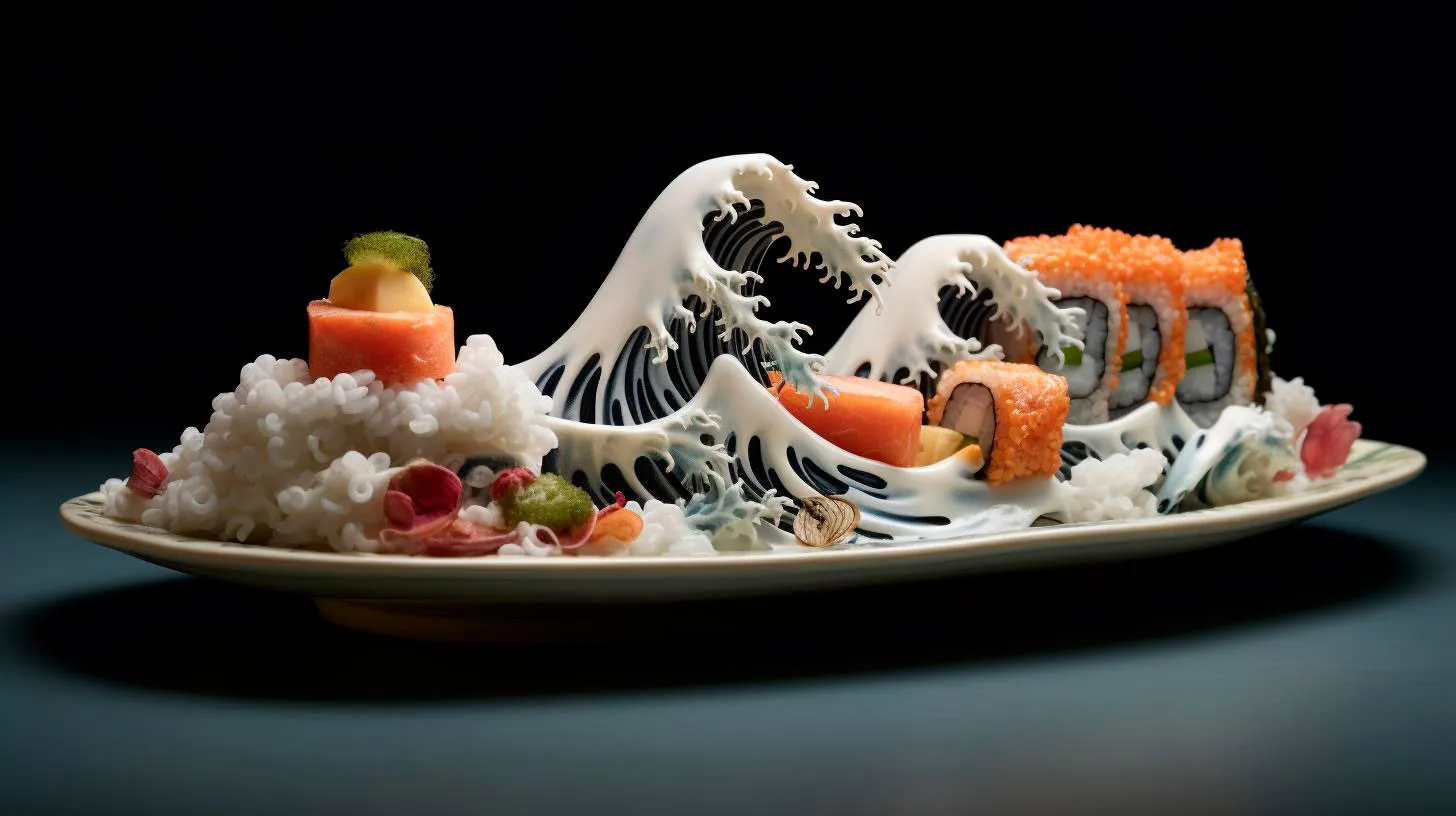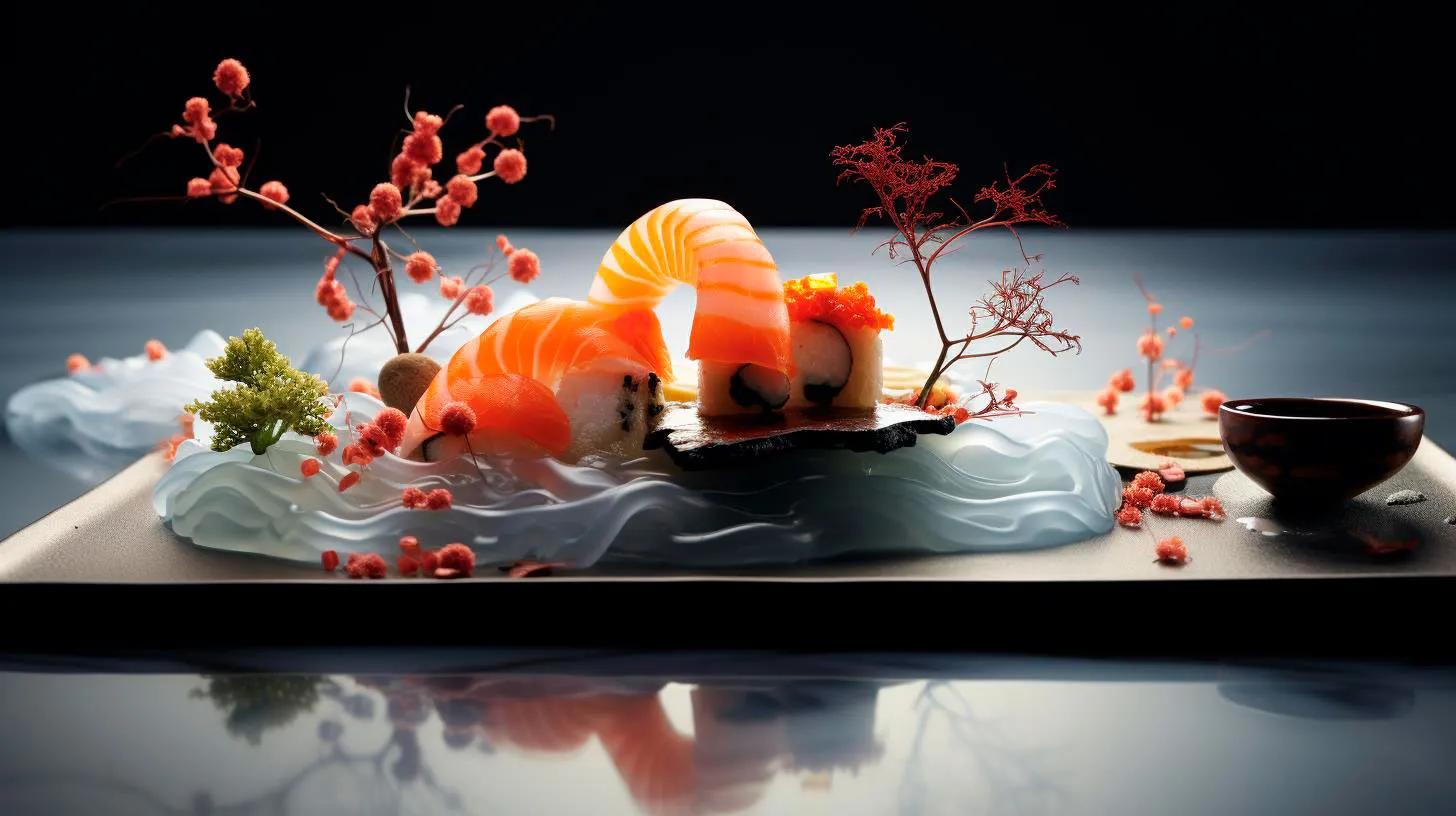Sacred Knife: The Spiritual Connection Between Samurai and Sushi
In this blog post, we will explore the spiritual connection between the samurai and sushi, uncovering the symbolic and historical significance of the sacred knife.
The Samurai Way
The samurai, revered as the noble warriors of feudal Japan, lived by a strict code known as Bushido, which emphasized honor, loyalty, and mastery of martial arts. The art of swordsmanship was at the core of their training, and the samurai valued their blades as extensions of their souls. Swords were believed to embody the spirit of its creator and become an inseparable part of the samurai’s identity.
The samurai’s reverence for their swords extended beyond the battlefield, influencing various aspects of Japanese culture. One such influence was the art of sushi making.
Sacred Knife: The Soul of Sushi
Similar to the samurai’s sword, the knife used in sushi preparation is held in high regard. It is not merely a tool but a sacred instrument that demands respect and skill. In the hands of a sushi chef, the knife becomes an extension of their creativity and expertise.
The traditional sushi knife, known as the yanagi, features a long, slender blade with a single-sided edge. This design enables precise cuts, ensuring the fish maintains its freshness and flavors. Sushi chefs spend years honing their knife skills, mastering the art of slicing with precision and elegance.
Every slice carries the essence of the chef’s training, devotion, and respect for the ingredients and the customers they serve. The knife becomes a conduit, channeling the chef’s intent and energy into each piece of sushi they create.
Symbolism and Rituals
Just as the samurai observed rituals in relation to their swords, sushi chefs perform various ceremonies and traditions involving their knives. These rituals serve to honor the history and traditions surrounding sushi and pay homage to the samurai’s code of honor.
- Knife purification: Before using their knives, sushi chefs often perform a cleansing ritual to spiritually purify the blade. This practice symbolizes respect for the tool and its connection to the samurai’s spirit.
- Knife presentation: Some sushi chefs go as far as presenting their knives in a special box, similar to how samurai would present their swords. This act serves as a reminder of the knife’s importance and demonstrates the chef’s dedication to their craft.
- Knife maintenance: Sushi chefs meticulously maintain their knives, often using ancient techniques passed down from previous generations. This care and attention ensure the knife’s longevity and preservation of its spiritual connection.
The Spiritual Bond
The bond between the samurai and sushi is more than a mere historical connection. It is a reflection of the unwavering dedication and mastery that define both the art of the samurai and the craft of sushi making. This spiritual link can be felt in every bite of sushi, as the precision and passion of the chef are transferred to the diner.
By preserving the traditions and rituals associated with the sacred knife, sushi chefs continue to honor the samurai’s legacy and embody the spirit of Bushido. Thus, sushi becomes not just a culinary delight but a captivating journey that connects the diner with ancient principles of honor, skill, and respect.
Key Takeaways
- The sacred knife used in sushi preparation holds deep symbolic and historical significance.
- Resembling the samurai’s sword, the sushi knife demands respect, skill, and mastery.
- Rituals and ceremonies surrounding the knife pay homage to the samurai and their code of honor.
- Sushi chefs demonstrate their dedication through knife purification, presentation, and maintenance.
- The spiritual bond between the samurai and sushi can be experienced through the precision and passion of the chef.
In conclusion, the spiritual connection between the samurai and sushi offers a unique perspective into the world of Japanese culture and cuisine. This ancient bond reminds us of the power and significance of tradition, transforming a simple meal into a captivating experience. As we savor each piece of sushi, let us appreciate the centuries of history and the spirit of the samurai that live on in the sacred knife.
Sashimi Secrets: Unveiling Samurai Techniques for Slicing Sushi
In this article, we will delve into the art of sashimi slicing and uncover the secrets of the samurai techniques used to create perfect slices of sushi-grade fish.
The Importance of Sashimi Slicing
When it comes to sashimi, slicing is everything. The way the fish is cut plays a crucial role in its texture, taste, and overall presentation. The art of sashimi slicing is deeply rooted in Japanese culinary tradition. It requires years of practice, attention to detail, and the use of specialized tools.
Without proper slicing techniques, the flavors of the fish can be compromised, and the texture can become tough. To maintain the integrity and quality of the fish, sushi chefs rely on certain principles and techniques that have been perfected over centuries.
The Samurai Techniques
Just like a samurai wielding a sword, a sushi chef must approach sashimi slicing with precision, focus, and respect for the ingredients. Here are some key techniques used by sushi masters:
1. Yanagi-ba: The Sword-Like Knife
The key tool for sashimi slicing is the yanagi-ba, a long, single-edged knife resembling a katana. The razor-sharp edge of this knife allows the chef to make clean cuts with minimal damage to the fish. The yanagi-ba requires skill and control to master, but once mastered, it becomes an extension of the chef’s hand.
2. Kiritsuke: The Versatile Knife
Another important knife in a sushi chef’s arsenal is the kiritsuke. With its unique shape and double-edged blade, the kiritsuke offers versatility in slicing both sashimi and other ingredients. This multi-purpose knife requires great skill and dexterity to handle effectively.
3. Tane: The Perfect Fish Selection
Selecting the right fish for sashimi is crucial. Sushi chefs prioritize freshness, texture, and flavor when choosing the fish. Each type of fish requires different handling and slicing techniques. The balance between flavor, texture, and visual appeal is the key to an exceptional sashimi experience.
4. Itamae: The Art of Slicing
The term “itamae” refers to a skilled sushi chef who possesses the knowledge and expertise in the art of slicing sashimi. This mastery goes beyond the physical act of cutting and extends to an understanding of the fish’s structure, texture, and optimal slicing angles. The itamae uses precise movements to create thin, uniform slices that accentuate the flavors of the sashimi.
Advantages of Samurai Slicing Techniques
Mastering the samurai techniques of sashimi slicing brings several advantages to sushi chefs and diners alike:
- Enhanced Flavor: Properly sliced sashimi allows the flavors of the fish to shine through, giving diners a true taste of the ocean.
- Improved Texture: Precise slicing techniques maintain the delicacy of the fish, ensuring a tender and melt-in-your-mouth texture.
- Visual Appeal: Thin, uniform slices arranged beautifully on a plate create an enticing visual presentation that enhances the dining experience.
- Optimal Fish Utilization: Samurai techniques maximize the yield from each fish, minimizing waste and ensuring sustainability.
Key Takeaways
Sashimi slicing is an ancient art that requires years of practice and dedication. To summarize the key takeaways:
- Proper tools, such as the yanagi-ba and kiritsuke, are essential for sashimi slicing.
- Choosing the right fish and understanding its unique characteristics is crucial for a successful sashimi dish.
- The itamae’s skills in precise slicing techniques elevate the flavors, texture, and presentation of sashimi.
- Samurai techniques not only enhance the dining experience but also contribute to sustainable fish utilization.
By embracing the techniques passed down through generations, sushi chefs continue to create exquisite sashimi dishes that honor tradition and captivate food enthusiasts worldwide. The next time you indulge in a plate of sashimi, take a moment to appreciate the mastery behind those perfectly sliced, delectable morsels.
The Samurai Blade: Mastering the Art of Slicing Sushi
The Art of Slicing Sushi
Sushi is not just a delightful treat for the taste buds; it is a visual masterpiece. And no aspect of sushi creation embodies this visual allure more than the precise and deliberate slicing of the ingredients. The art lies in the ability to create thin, flawless slices of fish and other ingredients, accentuating the flavors and textures of the sushi roll.
When it comes to slicing sushi, consistency and precision are key. Each piece of sushi should be uniform in size and shape, allowing for an even distribution of flavors. Achieving this level of precision requires a delicate touch and years of practice. But the tool used in this process is equally important – the samurai blade.
The Significance of the Samurai Blade
The samurai blade, also known as a yanagi ba or sashimi knife, is a traditional Japanese knife specifically designed for slicing sushi and sashimi. Crafted by skilled artisans, these knives are made with the utmost care and precision to ensure an unparalleled cutting experience.
What sets the samurai blade apart from other knives is its long, slender shape and single bevel edge. This unique design allows for a clean, precise cut with minimal surface resistance, ensuring that each slice is smooth and tear-free. The single bevel edge also enables skilled chefs to angle their cuts perfectly, enhancing the presentation and texture of the sushi.
Furthermore, the high-quality steel used in the production of samurai blades ensures exceptional sharpness and edge retention. This not only improves the efficiency of sushi preparation but also elevates the overall experience for both sushi chefs and enthusiasts.
The Mastery of Sushi Slicing
Mastering the art of slicing sushi takes years of dedication, practice, and precision. It is not only about sharpening your knife skills but also understanding the anatomy of the fish, the optimal cutting angles, and the level of pressure applied to each slice.
Here are some key takeaways to keep in mind while honing your sushi slicing prowess:
- Invest in a high-quality samurai blade: A sharp, well-crafted blade will significantly enhance your slicing technique.
- Practice proper grip and posture: Hold the knife with a relaxed grip and maintain a stable posture while slicing to ensure precision and control.
- Master the cutting angles: Understanding the angles at which the knife interacts with the ingredients allows you to create beautiful, uniform slices.
- Embrace patience and focus: Slicing sushi is a mindful practice that requires complete concentration and attention to detail.
By following these guidelines and continuously honing your skills, you can unlock the true potential of the samurai blade and create sushi that not only tantalizes the taste buds but also captivates the eyes.
Key Takeaways
The art of slicing sushi is a skill that requires precision, patience, and a keen eye for detail. Here are some key takeaways from this article:
- The samurai blade, a traditional Japanese knife, is the quintessential tool for slicing sushi.
- Its unique design allows for clean, precise cuts and enhances the overall presentation of sushi.
- Mastery of sushi slicing involves understanding the angles, pressure, and techniques required for consistent, uniform slices.
- Investing in a high-quality samurai blade and practicing proper grip and posture are crucial for mastering this art.
- Ultimately, the art of slicing sushi is about more than just technique; it is a beautiful marriage of skill, precision, and passion.
As you embark on your journey to master the art of slicing sushi, remember that it is not only a culinary endeavor but a pathway to connecting with centuries of tradition and culture. So grab your samurai blade, embrace the philosophy of the samurai, and let your sushi slicing skills flourish.
The Sacred Ritual: Samurai Wisdom in the Preparation of Sushi
In this article, we unveil the fascinating connection between samurai wisdom and the art of sushi-making, and explore the key takeaways we can learn from this revered practice.
The Perfect Balance of Flavors
To achieve the divine harmony of flavors found in sushi, one must understand the delicate balance between the ingredients. Just as a samurai seeks balance in battle, a sushi chef meticulously crafts each roll to blend flavors seamlessly. Packed with umami, the fifth taste sensation that adds depth and complexity to food, sushi showcases the genius combination of raw fish, vinegared rice, and other complementary elements. This mindful balance between sweet, salty, sour, and bitter flavors creates an explosion of tastes that leave diners craving for more.
- Feature: The perfect balance of flavors in sushi stimulates taste buds, providing an unforgettable culinary experience.
- Advantage: Sushi allows diners to savor a wide variety of flavors in a single bite, making it a versatile and exciting dining option.
- Key takeaway: Achieving balance in life, just like in sushi, is essential for overall harmony and fulfillment.
Attention to Detail and Craftsmanship
The creation of sushi requires meticulous attention to detail and a masterful display of craftsmanship. Just as a samurai refines their swordsmanship through years of practice, a sushi chef hones their skills through rigorous training. From the precise cutting of the fish to the gentle molding of the rice, every movement is deliberate and intentional. The chef’s hands become an extension of their soul, infusing each piece of sushi with their passion and dedication. This level of craftsmanship guarantees each sushi bite to be a work of art.
- Feature: Sushi preparation demands an exquisite attention to detail, ensuring the highest quality in taste and presentation.
- Advantage: The craftsmanship involved in sushi-making elevates it to a form of edible art, pleasing not only the taste buds but also the eyes.
- Key takeaway: Paying attention to details and pursuing excellence can lead to exceptional results in any endeavor.
The Beauty of Simplicity
In the world of sushi, simplicity reigns supreme. Just like a samurai’s minimalistic lifestyle, sushi encompasses elegance in its purest form. Every ingredient is carefully selected to showcase its natural flavors, and unnecessary embellishments are avoided. The focus is on purity and authenticity. This simplicity evokes a sense of tranquility and allows the diner to fully appreciate the essence of each ingredient, taking them on a journey of culinary bliss with every bite.
- Feature: Simplicity in sushi allows the natural flavors to shine, creating a harmonious and authentic culinary experience.
- Advantage: The simplicity of sushi makes it a versatile choice for anyone seeking a healthier, unprocessed meal option.
- Key takeaway: Embracing simplicity in life can lead to greater appreciation and a deeper connection with the essence of each experience.
In Closing
Sushi, a culinary art form embedded in samurai wisdom, offers more than just a delightful dining experience. It teaches us the virtues of balance, attention to detail, and the beauty of simplicity. Just as a samurai commits their life to their craft, sushi chefs dedicate themselves to perfecting this ancient tradition. So, the next time you savor a piece of sushi, remember the sacred ritual behind it and let the essence of samurai wisdom elevate your dining experience to new heights.


